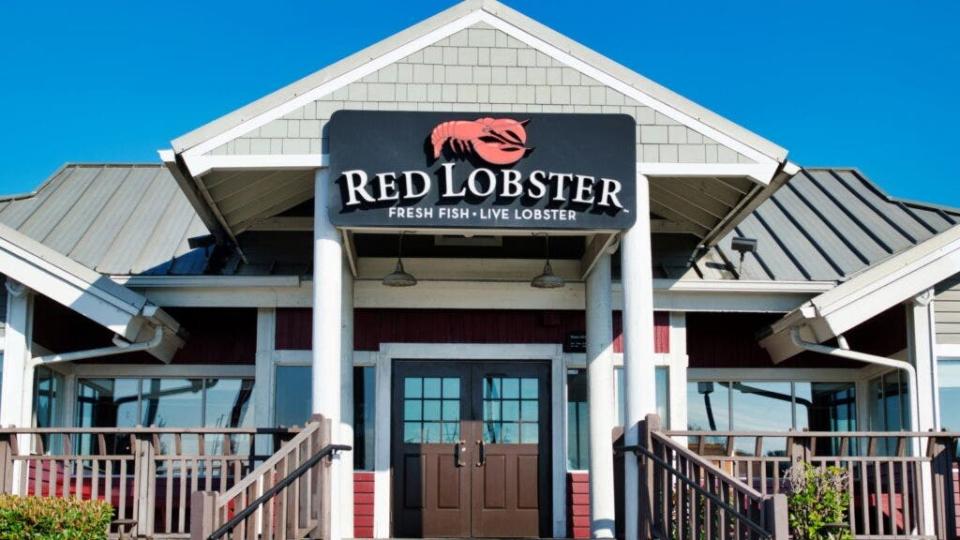It Was A Bad Real Estate Deal, Not A Bad Meal Deal That Killed Red Lobster

When the venerable Red Lobster restaurant chain filed for bankruptcy and announced it would be closing dozens of locations, the news didn't come as a surprise. Red Lobster had been struggling for years and the filing came on the heels of a highly publicized, equally ill-fated "all-you-can-eat" shrimp promotion. Although the shrimp promotion may have been a contributing cause, a deeper analysis reveals that a bad real estate deal killed Red Lobster.
In 1968, Red Lobster pioneered the semi-casual upscale dining trend that dominated the American restaurant scene in the 1980s, 90s, and even the early 2000s. The chain was a fixture at shopping malls across the country and carved out a unique market niche by offering higher-end seafood options like lobster to everyday Americans at an affordable price. It also became famous for its delicious Cheddar Bay biscuits.
Don't Miss:
Elon Musk and Jeff Bezos are bullish on one city that could dethrone New York and become the new financial capital of the US. Investing in its booming real estate market has never been more accessible.
Warren Buffett once said, "If you don't find a way to make money while you sleep, you will work until you die." These high-yield real estate notes that pay 7.5% – 9% make earning passive income easier than ever.
Unfortunately for Red Lobster, when foodie culture began taking hold around the country and Americans' collective palates became more sophisticated, the chain remained in the past. By the 2010s, Red Lobster was in real trouble, leading its original owners to sell it to San Francisco-based Golden Gate Capital in 2014.
Golden Gate could not engineer a turnaround and began selling equity shares to a seafood conglomerate, Thai Union, in 2016. On the surface, that deal made a lot of sense. Thai Union was in the seafood business, and owning one of America's most well-known seafood restaurants gave it a long-term customer for all its products.
Thai Union acquired its first equity shares in Red Lobster with a $575 million deal in 2016 and then joined a private consortium to buy Golden Gate out entirely in 2020. The timing could not have been worse. The COVID pandemic took a devastating toll on the American restaurant industry and Red Lobster was no exception. Their bankruptcy filing indicates that restaurant attendance is 30% below pre-pandemic levels.
Trending: Investing in real estate just got a whole lot simpler. This Jeff Bezos-backed startup will allow you to become a landlord in just 10 minutes, and you only need $100.
A steep customer decline would be disastrous for any restaurant, but it was even more devastating for Red Lobster. The reason traces back to Golden Gate’s original deal to buy Red Lobster. Golden Gate paid $2.1 billion for the chain, partly financed by a massive real estate deal.
Under the terms of that deal, Golden Gate sold the real estate for 500 Red Lobster locations to American Realty Capital for $1.5 billion and then leased them back. This transaction is known as a sale-leaseback arrangement, and it turned Golden Gate into an American Realty Group tenant with many locations locked into 25-year leases with 2% annual increases.
Making matters worse for Golden Gate was that the leases were triple net. That means in addition to the rent, Golden Gate would be responsible for paying the property taxes, insurance, and maintenance on the 500 locations it was leasing. It was a great deal for American Realty Group, and although it paved the way for Golden Gate's ownership, it left them with precious little margin for error or profit loss.
Industry analysts sounded the alarm almost immediately. Johnathan Maze of Restaurant Finance Monitor wrote, "Let’s get this straight. We’re taking a brand with badly falling sales and earnings, and will then load it up with rent costs?" He noted that the estimated $118.5 million annual rent obligation Golden Gate took on would be equivalent to roughly half the franchise's annual revenue.
By the end of the pandemic, Red Lobster's revenue was in decline, and the triple net lease payments were taking a massive bite out of what little money Red Lobster was making. Around that time, Red Lobster's current owner Thai Union, a massive shrimp wholesaler, began to push the now-infamous $20 all-you-can-eat shrimp promotion.
The promotion was popular with shrimp lovers, who flocked to Red Lobster and ate over $20 worth of shrimp. It also turned out to be the proverbial straw that broke the camel's back for Red Lobster. However, it's much more likely that the seeds of Red Lobster's demise were planted in the disastrous sales-leaseback arrangement of 2014.
Keep Reading:
A new fund backed by Jeff Bezos offers a 7-9% target yield with monthly dividends. Here’s how you can invest today.
The average American couple has saved this much money for retirement — How do you compare?
"ACTIVE INVESTORS' SECRET WEAPON" Supercharge Your Stock Market Game with the #1 "news & everything else" trading tool: Benzinga Pro - Click here to start Your 14-Day Trial Now!
Get the latest stock analysis from Benzinga?
This article It Was A Bad Real Estate Deal, Not A Bad Meal Deal That Killed Red Lobster originally appeared on Benzinga.com
© 2024 Benzinga.com. Benzinga does not provide investment advice. All rights reserved.

 Yahoo Finance
Yahoo Finance 